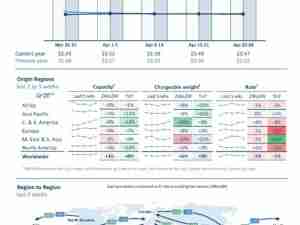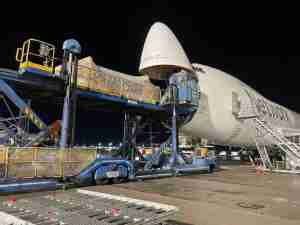Fitch Ratings has affirmed the ratings on the following regional origination and destination (O&D) airports; however, the Rating Outlooks have been revised to Negative from Stable:
• Ft. Lauderdale-Hollywood International Airport, FL (FLL) 'A+' rating on its airport system revenue bonds issued by the Broward County;
• Las Vegas-McCarran International Airport, NV (LAS) 'A+' rating on its subordinate lien airport system revenue bonds issued by Clark County;
• Kansas City International Airport, MO (MCI) 'A' rating on its airport special obligation bonds issued by The Industrial Development Authority of the City of Kansas City, MO;
• Southwest Florida International Airport, Ft Myers, FL (RSW) 'A' rating on its airport revenue bonds issued by Lee County Port Authority;
• Massachusetts Port Authority (BOS) MA 'AA' rating on its revenue bonds;
• Nashville International Airport, TN (BNA) 'A' rating on its subordinate airport revenue bonds issued by Metropolitan Nashville Airport Authority;
• New Orleans International Airport, LA (MSY) 'A' rating on the airport revenue bonds issued by the New Orleans Aviation Board;
• Port of Oakland, CA (OAK) 'A+' and 'A' ratings on the senior lien and intermediate lien revenue bonds and the 'A' underlying bank bond rating for the port's commercial paper notes;
• Raleigh-Durham International Airport, NC (RDU) 'AA-' rating on its airport revenue bonds issued by the Raleigh-Durham Airport Authority;
• San Antonio International Airport, TX (SAT) 'A+' and 'A' ratings on the senior lien and PFC/subordinate lien airport revenue bonds, respectively;
• San Diego International Airport, CA (SAN) 'AA-' and 'A+' ratings on the senior lien and subordinate lien revenue bonds, respectively, issued by the San Diego Regional Airport Authority;
• San Jose International Airport, CA (SJC) 'A' and 'A-' ratings on the senior lien airport revenue bonds and underlying subordinate lien bank bonds;
• St. Louis International Airport, MO (STL) 'A' rating on its airport revenue bonds.
RATING RATIONALE
The recent outbreak of coronavirus and related government containment measures worldwide create an uncertain global environment for air travel in the near term. While the above airport issuers' performance data through most recently available issuer data may not have indicated impairment, material changes in revenue and cost profile are occurring across the sector and likely to worsen in the coming weeks and months as economic activity suffers and government restrictions are maintained or expanded. Fitch's ratings are forward-looking in nature, and Fitch will monitor developments in the sector as a result of the virus outbreak as it relates to severity and duration, and incorporate revised base and rating case qualitative and quantitative inputs based on expectations for future performance and assessment of key risks.
Regional O&D Airport Rating Actions
The Negative Rating Outlook actions assigned to the above airport credits serving regional O&D markets reflects the current stressed environment in aviation, affecting origination-destination travel. Severe declines in enplaned passenger traffic will affect operating revenues across all of these airports, with the greatest impacts to occur in the second quarter of 2020 and potentially extend into future periods due to the coronavirus pandemic. These airports have midrange-to-stronger franchise positions but still operate with a moderate to high level of dependence on operations from leading carriers. In the near term, Fitch has assessed that for each of the airports above, the unrestricted cash reserves alone are sufficient to meet debt service due through the end of the current calendar year.
The drop in air travel is likely to be steeper than what was seen during prior global event episodes such as SARS and Sept. 11 terrorist attacks, and the start of the recovery period is difficult to assess as the virus spread is still growing in regions where air travel is most prevalent. Conditions are constantly changing given the fast moving nature of events, and U.S. airports are facing significant reductions in passenger traffic under this environment.
Fitch expects the dramatic reduction in air travel levels to increase financial pressure on all U.S. airports at varying levels, a sector that has had a decade long stretch of traffic expansion and financial stability. The unprecedented requests in recent days for assistance from the federal government by both the air carriers and the airports are indicative of the mutual strains suffered in the aviation industry and demonstrate a clear signal of the present financial pressures. Robust liquidity across most airports, evident through a combination of cash funded bond reserves and additional accounts with unencumbered funds, should provide additional protection to cover upcoming bond payments and is viewed as a mitigating consideration.
The CARES Act, which provides a total of $7.4 billion out of $10 billion of federal funding to U.S. airports to use for any lawful airport purpose, provides additional mitigation. The assistance is intended to provide near-term bridge funding for lost revenues until enplanements can meaningfully return to pre-crisis levels and airports are expected to use the funds for a variety of purposes ranging from rate relief to air carriers and concession tenants to directly offsetting operating costs and upcoming debt payments. While the passage of the CARES Act reduces the risk of downgrades somewhat, it is not enough to result in Stable Outlooks at this time given the remaining uncertainties in the sector, including but not limited to, the severity and duration of enplanement losses, the length of the recovery period, the extent of revenue underperformance, and the financial health, willingness, ability of air carriers to make full and timely payments.
Fitch also expects airport management to initiate a number of self-protective actions to preserve their fiscal postures, although there are limitations given the broad impairment to the general economy and the industries tied to the aviation sector. Airline agreements in most cases are structured to provide mechanisms to revise airline payment levels in case of large variances to budgeted performance; however, the airlines themselves are financially constrained to the point this approach is not anticipated. Further analysis will follow in the weeks to come with detailed analyses of management reactions and responses, as well as incoming data on traffic, revenues and expense control actions. In the longer term, Fitch will analyze traffic and revenue impacts caused by possible changes in air travel patterns.
Fitch conducted a rating case and a sensitivity case to the above credits to assess coverage and liquidity. The rating case scenario, which contemplates airport enplanement declines of approximately 35% in calendar year 2020 relative to 2019 actual levels based on the following assumptions of quarterly traffic activity: Q1 2020 (-15%), Q2 2020 (-60%); Q3 2020 (-40%) and Q4 2020 (-20%). For calendar years 2021 and 2022, Fitch assumes 95% and 100% recoveries relative to 2019 levels. Recognizing there are different fiscal year periods for each airport, the assumed traffic levels will be accordingly adjusted. A more severe sensitivity case assumes traffic declines continue at the same peak traffic loss of Q2 2020 for an additional quarterly period followed by recoveries that are similar to the rating case. The results of these scenarios will be published as a coronavirus stress test.
KEY RATING DRIVERS
See links below to individual issuer Rating Action Commentaries with individual Key Rating Driver assessment scores and analysis.
RATING SENSITIVITIES
Developments That May, Individually or Collectively, Lead to Positive Rating Action:
• A positive rating action is not expected in the near future. However, a return to a Stable Outlook could be possible, and the ratings affirmed, if Fitch sees sustained recovery in traffic and revenues due to the easing of the pandemic resulting in normal air traffic patterns or the adaption of strategies that convincingly stabilizes the finances.
Developments That May, Individually or Collectively, Lead to Negative Rating Action:
• A continued period of material traffic declines that presents further challenges to stabilize the finances of the affected airports;
• Further credit erosion of the major air carriers or payment delinquencies to the airports;
• Sustained deterioration in airport liquidity levels.








